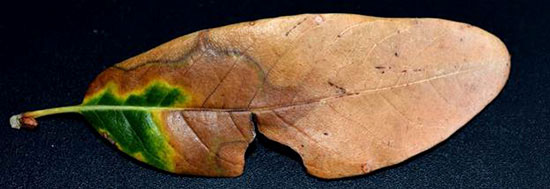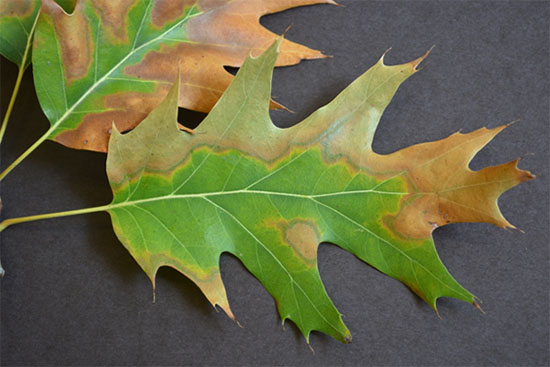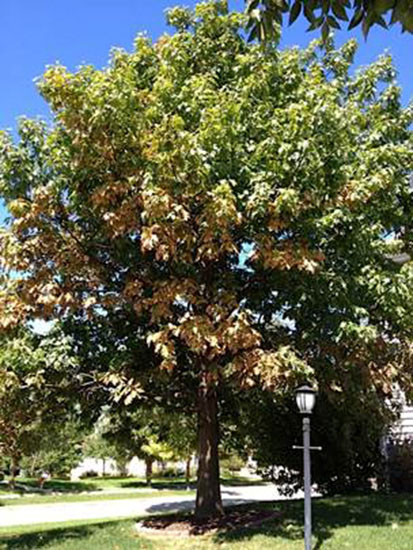Issue 12, August 11, 2014
Bacterial Leaf Scorch (BLS): What You Need to Know and How to Get It Tested
What is bacterial leaf scorch?
Bacterial leaf scorch (BLS) is an infectious disease caused by bacterium Xylella fastidiosa that spreads systemically and causes a slow decline and death of the tree. The disease affects many species of trees and shrubs. The bacterial pathogen is found only in xylem tissue. Xylem-feeding leafhoppers, treehoppers, and spittlebugs are thought to spread the bacterium from tree to tree. The disease can also be transmitted between trees through root grafts. Fortunately, this disease does not rapidly spread. BLS is not new, but is beginning to appear more frequently in the Midwest. Possibly this is a function of more people recognizing the symptoms. It has been noted that drought conditions can cause greater disease severity and may make symptoms more noticeable.
What trees are affected by BLS?
The most frequent hosts of this disease include oak, elm, sycamore, mulberry, sweet gum, London plane, hackberry, ginkgo, sugar maple, and red maple. Be aware, that many other landscape trees can be susceptible to this disease. Most of the samples submitted to the U of I Plant Clinic are oaks. Last year, we tested 23 trees from around the Midwest (not all were from Illinois) and found that 11 were positive for BLS. Thus far, in Illinois, BLS commonly infects pin and red oaks. In 2013, we tested a ginkgo leaf that was suspected to be positive for BLS; however, the tissue that was tested was old and I would like to confirm results with a resample. Trees are not the only plant hosts that have been found to be infected with Xylella fastidiosa. The bacterium has been found to have a wide host range including grasses and broad-leaved plants in some 30 families. It has also been found that some plant hosts may be "asymptomatic" and not exhibit symptoms. Some of the plants that have been found to harbor the bacterial pathogen that causes BLS are listed in http://extension.psu.edu/pests/plant-diseases/all-fact-sheets/bacterial-leaf-scorch.
What are the symptoms of BLS?
Look for scorch symptoms that occur in early summer to midsummer and then intensify in late summer. Affected leaf tissues initially have a chlorotic or faded green color that eventually transitions to brown. A yellow or reddish-brown color often separates scorched tissues from healthy green tissues. Symptoms will often show on the oldest leaves first, distinguishing this disease from environmental scorch that first appears on the newest leaves. The symptoms occur first on one branch or section of branches and slowly spread through the crown of the tree from year to year.
What are the symptoms of BLS on oaks?
Most references say that oaks show symptoms on an entire branch at once. Bacterial scorch often allows infected leaves to remain on the tree until the fall. Oaks are again the exception. They will drop leaves early. If you have seen a slow decline in your oak, leaf scorch symptoms showing each July to August, and fall leaf drop about a month ahead of healthy oaks, BLS may be present.
How can I diagnose Bacterial Leaf Scorch?
BLS can be easily mistaken for other environmental, disease, or cultural problems. Diagnosis cannot be based on symptoms alone. Oak wilt, drought stress, unfavorable site, construction damage, improper planting, girdling roots, root and butt rot, and canker fungi can all cause symptoms similar to those of BLA. Submitting a sample to a plant diagnostic laboratory is the only way to definitively diagnose the disease. Late summer or early fall is the best time to test for BLS, because this is when Xylella fastidious is most active and bacterial populations are high in the tree's water conducting tissues. Testing for this disease too early in the growing season can result in false negative results.

Shingle oak infected with bacterial leaf scorch (Xylella fastidiosa)

Red oak infected with bacterial leaf scorch (Xylella fastidiosa)

Oak tree infected with bacterial leaf scorch (Xylella fastidiosa)
Testing for BLS at the U of I Plant Clinic
The U of I Plant Clinic will be testing for BLS at the end of the month. The fee will be $25 per sample. It is suggested that you call ahead to be certain you have prepared the correct sample and avoid resampling at your expense. Petiole tissue from symptomatic leaves is preferred for this test, so leaves showing symptoms with green petioles are the usual request. Please send your samples in the next several weeks. We will collect samples, store them, and then run ONE serological test on all the submitted samples at the end of August, 2014.
What is the management of BLS?
There are no effective control options available once a tree is infected with BLS.
- Insecticide treatment of the insect vector is considered impractical and is not recommended.
- Trunk injections with antibiotics have been found to suppress symptoms, but will not eradicate the disease. Treatments can be done each year into the root flare at the base of the tree in late May or early June. Research has shown that injections are not an effective long-term solution for this disease. In addition, research has also shown that injection holes can be an entry way for wood rotting organisms and frequent retreatment can cause considerable damage over the life of the tree.
- Pruning can be done to help the aesthetics of the tree for a few years but has not been shown to slow the disease development.
- Mulching and watering during times of drought may help to prolong the life of the tree.
- The effects of fertilization are still not clear with this disease.
- Tree replacement with a non-susceptible host to BLS before the tree infected with BLS is removed is recommended. Some trees that have not been found to be affected by BLS can be found at the following http://www2.ca.uky.edu/agcollege/plantpathology/ext_files/PPFShtml/PPFS-OR-W-12.pdf. Removing the tree infected with BLS may be necessary for safety.
Other BLS Fact sheets:
http://www.usna.usda.gov/Research/BacterialLeafScorch.html
http://pubs.ext.vt.edu/3001/3001-1433/3001-1433.html
(Travis Cleveland & The University of Illinois Plant Clinic)
Author:
Travis Cleveland